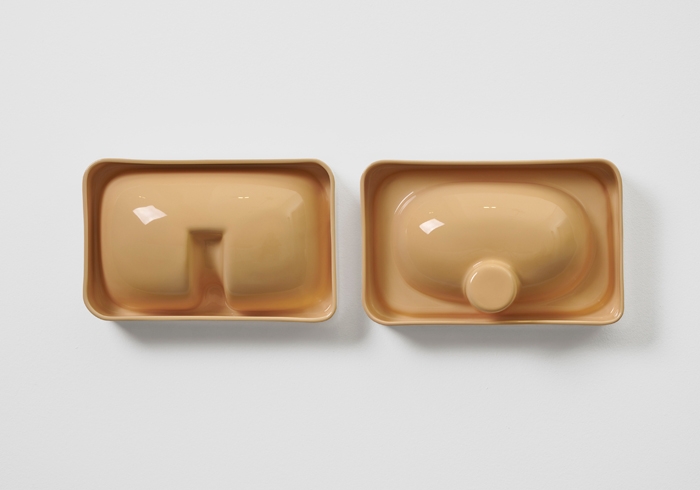The revelation of hidden structures – of a city, of a body – is something of a red herring in the work of Nicolas Deshayes. His previous show at Modern Art saw him pump hot water through a network of wall-mounted pipes interrupted in places by foamy, intestine-shaped sculptures that functioned as heaters (the title, Thames Water, pointed to his channelling of London’s public water supply). The slick, shiny surfaces of the 25 small earthenware sculptures in this new show, installed alternately on waist-high plinths or hung at eye-level, pushes the investigation into the lavatorial realm, summoning the kitschy, intimate world of a private bathroom.
A quick scan of the room reveals familiar shapes, some evoking functional appliances – sinks, toilet covers, hand dryers, a tissue box – and others suggesting body parts – buttocks, breasts, a bloated belly – with the occasional surprise inclusion, such as a large, ripe-green avocado half. But on closer inspection things are not quite as easily categorised: a recurring disjunction with the expected colours, forms and textures messes with one’s first assumptions. Hung by the gallery entrance, the two-part Fresh Towels (all works 2018) looks initially like casts of the front and back of a wall-mounted hand dryer, yet in that flesh colour, they also suggests the curves of a body, the back part of the cast in particular evoking a pair of cheeks on a Playmobil doll. A standing sculpture resembling a protruding belly might – on second thoughts, and after looking up its title (Spud) – simply recreate the shape of a potato.
The sculptures were all made using slipcasting, a technique associated with the mass production of ceramics, in which liquefied clay is poured into a plaster mould: when the defining outline has dried, the remaining clay is poured out. In Deshayes’ recourse to industrial or mass production techniques and materials, as well as in the pared-down aesthetics of the works and their presentation, there’s a distant echo of Minimalism’s formalist approach (a lineage perhaps intentionally hinted at by the gallery’s concurrent presentation of Charlotte Posenenske’s cardboard modules in the upper gallery). Yet the works’ sensuality, taunting playfulness and referencing of the most basic details of our daily lives feel refreshingly free of deadening conceptual rigour and rigid principles.
If anything, displayed neatly against the pristine walls of the gallery, these objects seem to deliver a tongue-in-cheek comment on our contemporary obsession with cleanliness – and its inherent relegation of bodily functions to the abject, to be concealed – by elevating and celebrating the objects’ triviality. The titular pair of Swans – each reduced to a white ovoid base, with a long tubular neck resting on top of it – occupy an isolated plinth, flaunting their immaculateness. Another such sculpture, painted in warm brown, seems to have had its purity compromised; Kensington reads the title, suddenly conjuring the chic tint of leather – beauty is a matter of expectation.
Nicolas Deshayes: Swans at Modern Art, Vyner Street, London, 12 January – 16 February
From the April 2019 issue of ArtReview
